Analysis of Leadership and Operations Management Approaches
VerifiedAdded on 2024/05/30
|15
|4318
|126
Report
AI Summary
This report provides a detailed analysis of leadership and operations management, beginning with a comparison of the roles and characteristics of leaders and managers, using BMW Motor Company as a case study. It examines how these roles apply in different situational contexts and applies various leadership theories, including situational, systems, and contingency leadership. The report then transitions to Amazon.com, Inc., to explain key approaches to operations management such as Just-in-Time, Total Quality Management, Continuous Improvement, Six Sigma, Lean Production, and queuing, highlighting the roles of leaders and managers. It emphasizes the importance of operations management in achieving business objectives and assesses the environmental factors impacting operational decision-making. The analysis concludes by summarizing the critical aspects of leadership and operations management and their combined impact on organizational success.

Management and operations
1
1
Paraphrase This Document
Need a fresh take? Get an instant paraphrase of this document with our AI Paraphraser
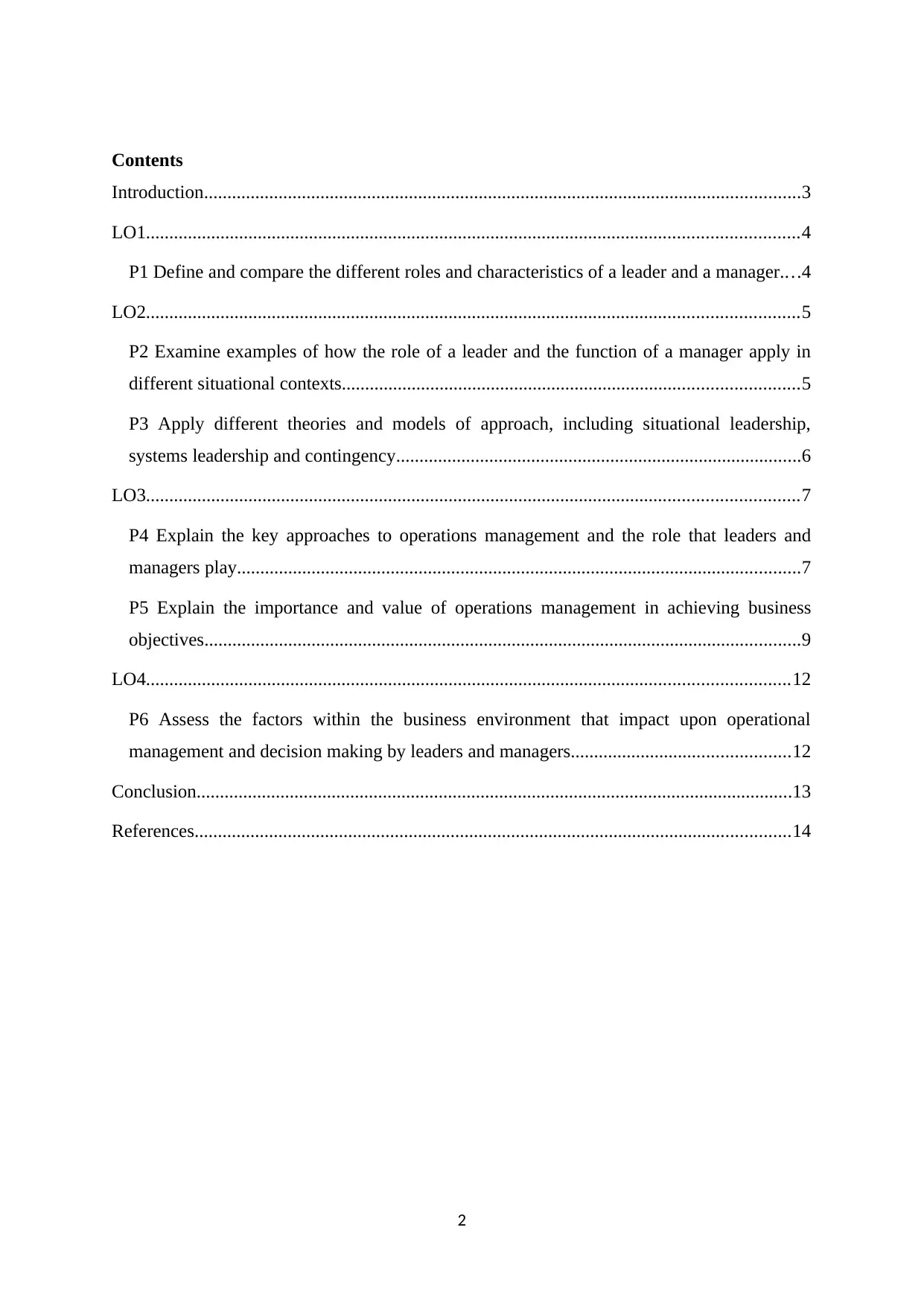
Contents
Introduction................................................................................................................................3
LO1............................................................................................................................................4
P1 Define and compare the different roles and characteristics of a leader and a manager....4
LO2............................................................................................................................................5
P2 Examine examples of how the role of a leader and the function of a manager apply in
different situational contexts..................................................................................................5
P3 Apply different theories and models of approach, including situational leadership,
systems leadership and contingency.......................................................................................6
LO3............................................................................................................................................7
P4 Explain the key approaches to operations management and the role that leaders and
managers play.........................................................................................................................7
P5 Explain the importance and value of operations management in achieving business
objectives................................................................................................................................9
LO4..........................................................................................................................................12
P6 Assess the factors within the business environment that impact upon operational
management and decision making by leaders and managers...............................................12
Conclusion................................................................................................................................13
References................................................................................................................................14
2
Introduction................................................................................................................................3
LO1............................................................................................................................................4
P1 Define and compare the different roles and characteristics of a leader and a manager....4
LO2............................................................................................................................................5
P2 Examine examples of how the role of a leader and the function of a manager apply in
different situational contexts..................................................................................................5
P3 Apply different theories and models of approach, including situational leadership,
systems leadership and contingency.......................................................................................6
LO3............................................................................................................................................7
P4 Explain the key approaches to operations management and the role that leaders and
managers play.........................................................................................................................7
P5 Explain the importance and value of operations management in achieving business
objectives................................................................................................................................9
LO4..........................................................................................................................................12
P6 Assess the factors within the business environment that impact upon operational
management and decision making by leaders and managers...............................................12
Conclusion................................................................................................................................13
References................................................................................................................................14
2
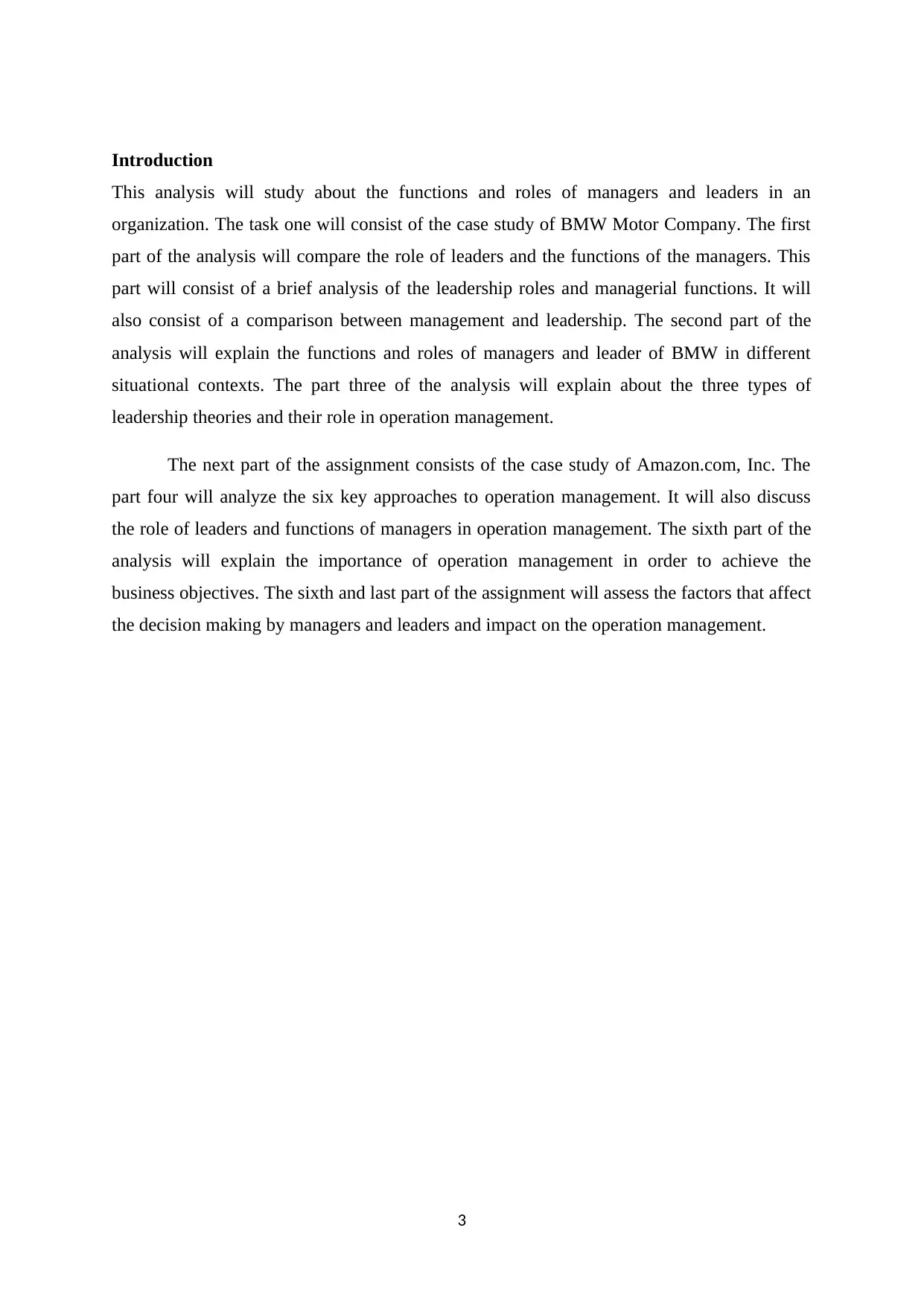
Introduction
This analysis will study about the functions and roles of managers and leaders in an
organization. The task one will consist of the case study of BMW Motor Company. The first
part of the analysis will compare the role of leaders and the functions of the managers. This
part will consist of a brief analysis of the leadership roles and managerial functions. It will
also consist of a comparison between management and leadership. The second part of the
analysis will explain the functions and roles of managers and leader of BMW in different
situational contexts. The part three of the analysis will explain about the three types of
leadership theories and their role in operation management.
The next part of the assignment consists of the case study of Amazon.com, Inc. The
part four will analyze the six key approaches to operation management. It will also discuss
the role of leaders and functions of managers in operation management. The sixth part of the
analysis will explain the importance of operation management in order to achieve the
business objectives. The sixth and last part of the assignment will assess the factors that affect
the decision making by managers and leaders and impact on the operation management.
3
This analysis will study about the functions and roles of managers and leaders in an
organization. The task one will consist of the case study of BMW Motor Company. The first
part of the analysis will compare the role of leaders and the functions of the managers. This
part will consist of a brief analysis of the leadership roles and managerial functions. It will
also consist of a comparison between management and leadership. The second part of the
analysis will explain the functions and roles of managers and leader of BMW in different
situational contexts. The part three of the analysis will explain about the three types of
leadership theories and their role in operation management.
The next part of the assignment consists of the case study of Amazon.com, Inc. The
part four will analyze the six key approaches to operation management. It will also discuss
the role of leaders and functions of managers in operation management. The sixth part of the
analysis will explain the importance of operation management in order to achieve the
business objectives. The sixth and last part of the assignment will assess the factors that affect
the decision making by managers and leaders and impact on the operation management.
3
⊘ This is a preview!⊘
Do you want full access?
Subscribe today to unlock all pages.

Trusted by 1+ million students worldwide
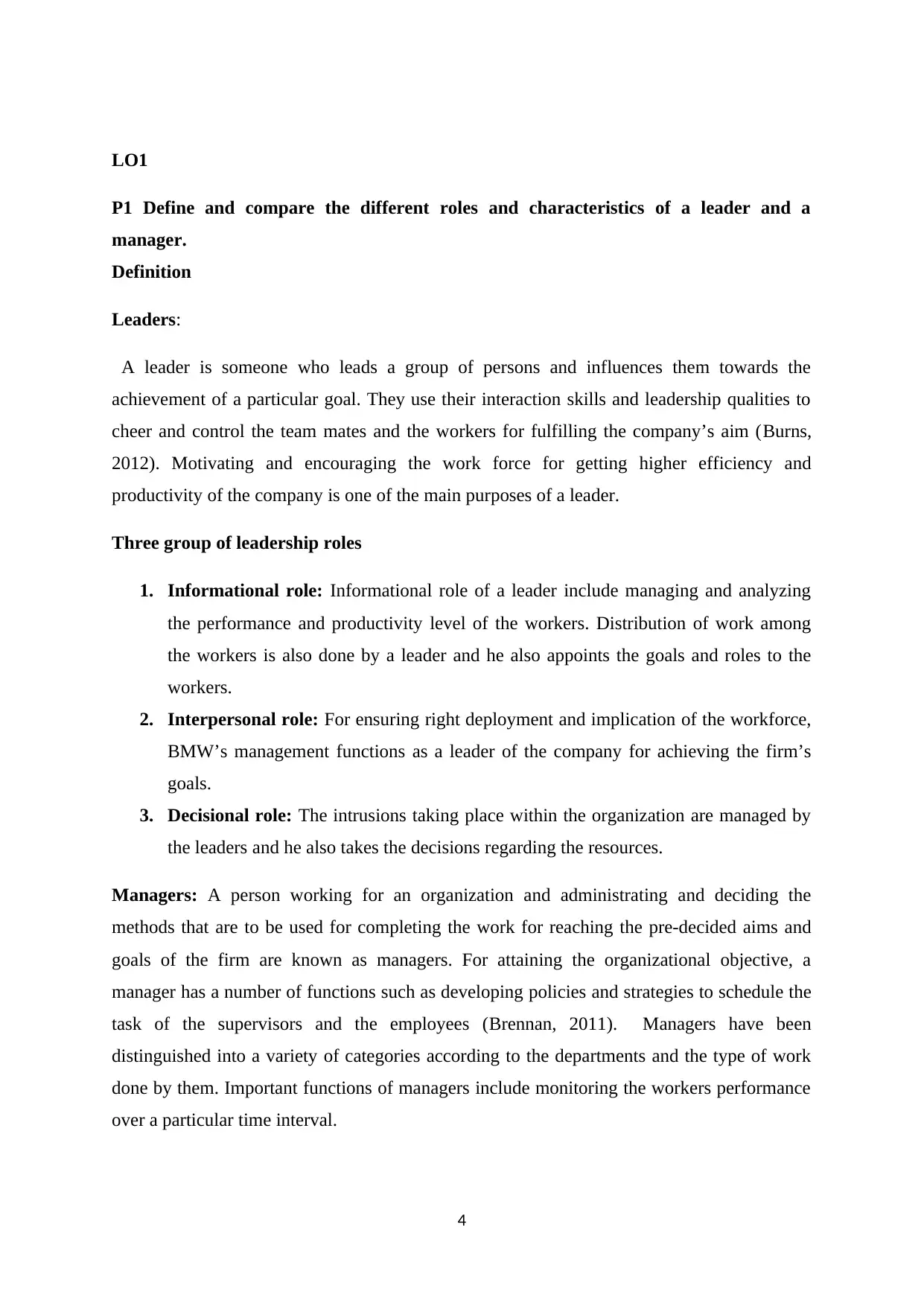
LO1
P1 Define and compare the different roles and characteristics of a leader and a
manager.
Definition
Leaders:
A leader is someone who leads a group of persons and influences them towards the
achievement of a particular goal. They use their interaction skills and leadership qualities to
cheer and control the team mates and the workers for fulfilling the company’s aim (Burns,
2012). Motivating and encouraging the work force for getting higher efficiency and
productivity of the company is one of the main purposes of a leader.
Three group of leadership roles
1. Informational role: Informational role of a leader include managing and analyzing
the performance and productivity level of the workers. Distribution of work among
the workers is also done by a leader and he also appoints the goals and roles to the
workers.
2. Interpersonal role: For ensuring right deployment and implication of the workforce,
BMW’s management functions as a leader of the company for achieving the firm’s
goals.
3. Decisional role: The intrusions taking place within the organization are managed by
the leaders and he also takes the decisions regarding the resources.
Managers: A person working for an organization and administrating and deciding the
methods that are to be used for completing the work for reaching the pre-decided aims and
goals of the firm are known as managers. For attaining the organizational objective, a
manager has a number of functions such as developing policies and strategies to schedule the
task of the supervisors and the employees (Brennan, 2011). Managers have been
distinguished into a variety of categories according to the departments and the type of work
done by them. Important functions of managers include monitoring the workers performance
over a particular time interval.
4
P1 Define and compare the different roles and characteristics of a leader and a
manager.
Definition
Leaders:
A leader is someone who leads a group of persons and influences them towards the
achievement of a particular goal. They use their interaction skills and leadership qualities to
cheer and control the team mates and the workers for fulfilling the company’s aim (Burns,
2012). Motivating and encouraging the work force for getting higher efficiency and
productivity of the company is one of the main purposes of a leader.
Three group of leadership roles
1. Informational role: Informational role of a leader include managing and analyzing
the performance and productivity level of the workers. Distribution of work among
the workers is also done by a leader and he also appoints the goals and roles to the
workers.
2. Interpersonal role: For ensuring right deployment and implication of the workforce,
BMW’s management functions as a leader of the company for achieving the firm’s
goals.
3. Decisional role: The intrusions taking place within the organization are managed by
the leaders and he also takes the decisions regarding the resources.
Managers: A person working for an organization and administrating and deciding the
methods that are to be used for completing the work for reaching the pre-decided aims and
goals of the firm are known as managers. For attaining the organizational objective, a
manager has a number of functions such as developing policies and strategies to schedule the
task of the supervisors and the employees (Brennan, 2011). Managers have been
distinguished into a variety of categories according to the departments and the type of work
done by them. Important functions of managers include monitoring the workers performance
over a particular time interval.
4
Paraphrase This Document
Need a fresh take? Get an instant paraphrase of this document with our AI Paraphraser
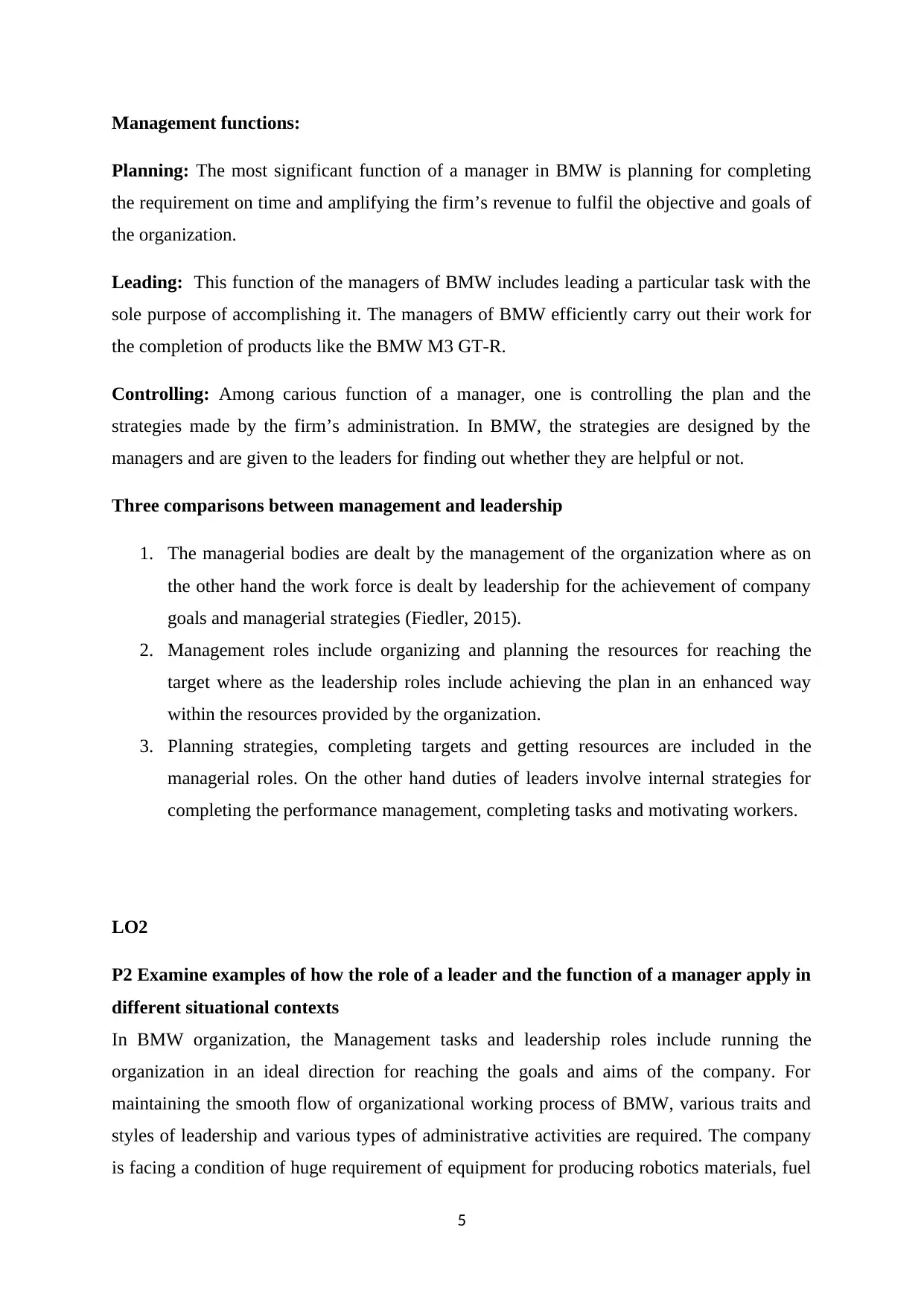
Management functions:
Planning: The most significant function of a manager in BMW is planning for completing
the requirement on time and amplifying the firm’s revenue to fulfil the objective and goals of
the organization.
Leading: This function of the managers of BMW includes leading a particular task with the
sole purpose of accomplishing it. The managers of BMW efficiently carry out their work for
the completion of products like the BMW M3 GT-R.
Controlling: Among carious function of a manager, one is controlling the plan and the
strategies made by the firm’s administration. In BMW, the strategies are designed by the
managers and are given to the leaders for finding out whether they are helpful or not.
Three comparisons between management and leadership
1. The managerial bodies are dealt by the management of the organization where as on
the other hand the work force is dealt by leadership for the achievement of company
goals and managerial strategies (Fiedler, 2015).
2. Management roles include organizing and planning the resources for reaching the
target where as the leadership roles include achieving the plan in an enhanced way
within the resources provided by the organization.
3. Planning strategies, completing targets and getting resources are included in the
managerial roles. On the other hand duties of leaders involve internal strategies for
completing the performance management, completing tasks and motivating workers.
LO2
P2 Examine examples of how the role of a leader and the function of a manager apply in
different situational contexts
In BMW organization, the Management tasks and leadership roles include running the
organization in an ideal direction for reaching the goals and aims of the company. For
maintaining the smooth flow of organizational working process of BMW, various traits and
styles of leadership and various types of administrative activities are required. The company
is facing a condition of huge requirement of equipment for producing robotics materials, fuel
5
Planning: The most significant function of a manager in BMW is planning for completing
the requirement on time and amplifying the firm’s revenue to fulfil the objective and goals of
the organization.
Leading: This function of the managers of BMW includes leading a particular task with the
sole purpose of accomplishing it. The managers of BMW efficiently carry out their work for
the completion of products like the BMW M3 GT-R.
Controlling: Among carious function of a manager, one is controlling the plan and the
strategies made by the firm’s administration. In BMW, the strategies are designed by the
managers and are given to the leaders for finding out whether they are helpful or not.
Three comparisons between management and leadership
1. The managerial bodies are dealt by the management of the organization where as on
the other hand the work force is dealt by leadership for the achievement of company
goals and managerial strategies (Fiedler, 2015).
2. Management roles include organizing and planning the resources for reaching the
target where as the leadership roles include achieving the plan in an enhanced way
within the resources provided by the organization.
3. Planning strategies, completing targets and getting resources are included in the
managerial roles. On the other hand duties of leaders involve internal strategies for
completing the performance management, completing tasks and motivating workers.
LO2
P2 Examine examples of how the role of a leader and the function of a manager apply in
different situational contexts
In BMW organization, the Management tasks and leadership roles include running the
organization in an ideal direction for reaching the goals and aims of the company. For
maintaining the smooth flow of organizational working process of BMW, various traits and
styles of leadership and various types of administrative activities are required. The company
is facing a condition of huge requirement of equipment for producing robotics materials, fuel
5
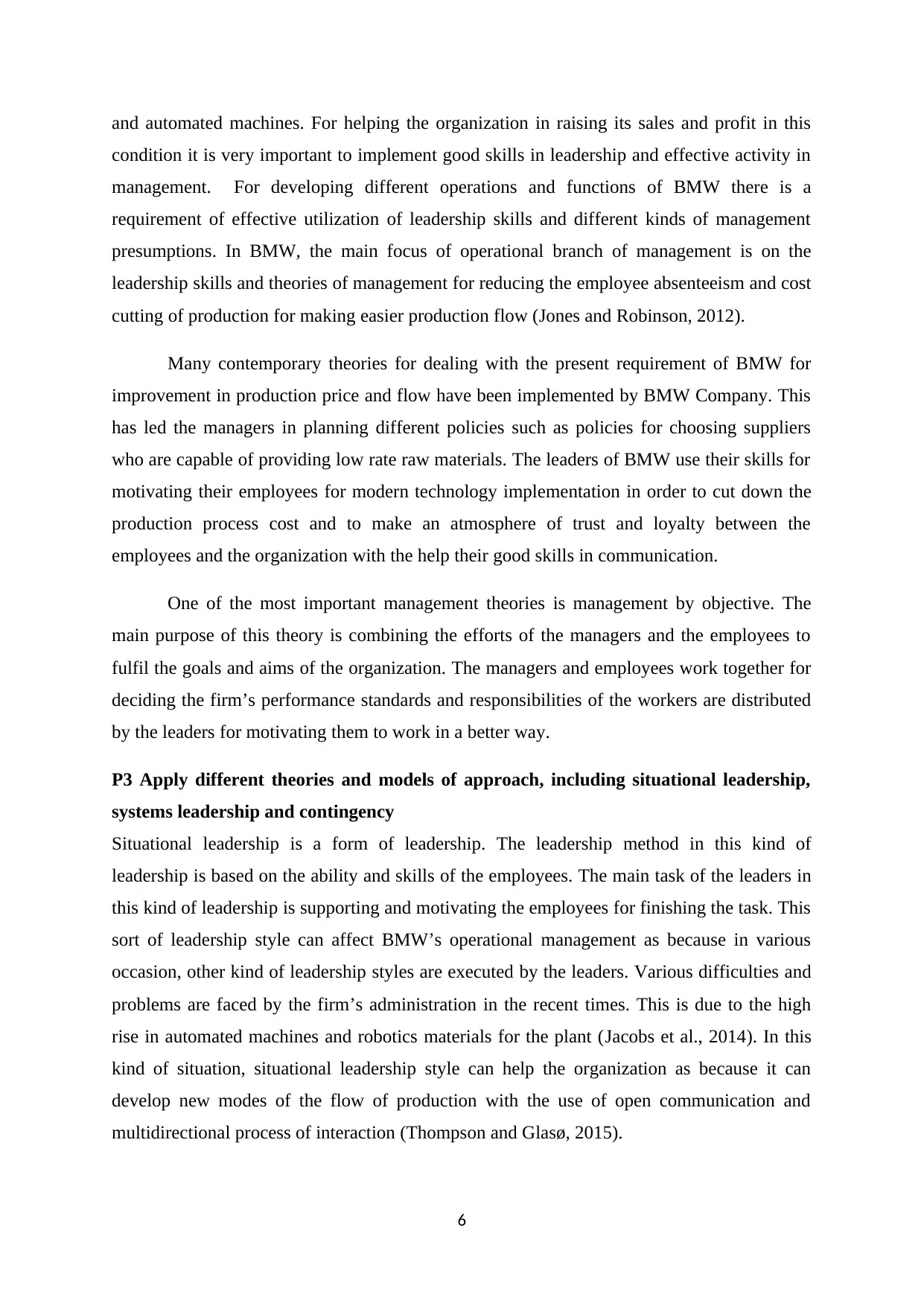
and automated machines. For helping the organization in raising its sales and profit in this
condition it is very important to implement good skills in leadership and effective activity in
management. For developing different operations and functions of BMW there is a
requirement of effective utilization of leadership skills and different kinds of management
presumptions. In BMW, the main focus of operational branch of management is on the
leadership skills and theories of management for reducing the employee absenteeism and cost
cutting of production for making easier production flow (Jones and Robinson, 2012).
Many contemporary theories for dealing with the present requirement of BMW for
improvement in production price and flow have been implemented by BMW Company. This
has led the managers in planning different policies such as policies for choosing suppliers
who are capable of providing low rate raw materials. The leaders of BMW use their skills for
motivating their employees for modern technology implementation in order to cut down the
production process cost and to make an atmosphere of trust and loyalty between the
employees and the organization with the help their good skills in communication.
One of the most important management theories is management by objective. The
main purpose of this theory is combining the efforts of the managers and the employees to
fulfil the goals and aims of the organization. The managers and employees work together for
deciding the firm’s performance standards and responsibilities of the workers are distributed
by the leaders for motivating them to work in a better way.
P3 Apply different theories and models of approach, including situational leadership,
systems leadership and contingency
Situational leadership is a form of leadership. The leadership method in this kind of
leadership is based on the ability and skills of the employees. The main task of the leaders in
this kind of leadership is supporting and motivating the employees for finishing the task. This
sort of leadership style can affect BMW’s operational management as because in various
occasion, other kind of leadership styles are executed by the leaders. Various difficulties and
problems are faced by the firm’s administration in the recent times. This is due to the high
rise in automated machines and robotics materials for the plant (Jacobs et al., 2014). In this
kind of situation, situational leadership style can help the organization as because it can
develop new modes of the flow of production with the use of open communication and
multidirectional process of interaction (Thompson and Glasø, 2015).
6
condition it is very important to implement good skills in leadership and effective activity in
management. For developing different operations and functions of BMW there is a
requirement of effective utilization of leadership skills and different kinds of management
presumptions. In BMW, the main focus of operational branch of management is on the
leadership skills and theories of management for reducing the employee absenteeism and cost
cutting of production for making easier production flow (Jones and Robinson, 2012).
Many contemporary theories for dealing with the present requirement of BMW for
improvement in production price and flow have been implemented by BMW Company. This
has led the managers in planning different policies such as policies for choosing suppliers
who are capable of providing low rate raw materials. The leaders of BMW use their skills for
motivating their employees for modern technology implementation in order to cut down the
production process cost and to make an atmosphere of trust and loyalty between the
employees and the organization with the help their good skills in communication.
One of the most important management theories is management by objective. The
main purpose of this theory is combining the efforts of the managers and the employees to
fulfil the goals and aims of the organization. The managers and employees work together for
deciding the firm’s performance standards and responsibilities of the workers are distributed
by the leaders for motivating them to work in a better way.
P3 Apply different theories and models of approach, including situational leadership,
systems leadership and contingency
Situational leadership is a form of leadership. The leadership method in this kind of
leadership is based on the ability and skills of the employees. The main task of the leaders in
this kind of leadership is supporting and motivating the employees for finishing the task. This
sort of leadership style can affect BMW’s operational management as because in various
occasion, other kind of leadership styles are executed by the leaders. Various difficulties and
problems are faced by the firm’s administration in the recent times. This is due to the high
rise in automated machines and robotics materials for the plant (Jacobs et al., 2014). In this
kind of situation, situational leadership style can help the organization as because it can
develop new modes of the flow of production with the use of open communication and
multidirectional process of interaction (Thompson and Glasø, 2015).
6
⊘ This is a preview!⊘
Do you want full access?
Subscribe today to unlock all pages.

Trusted by 1+ million students worldwide
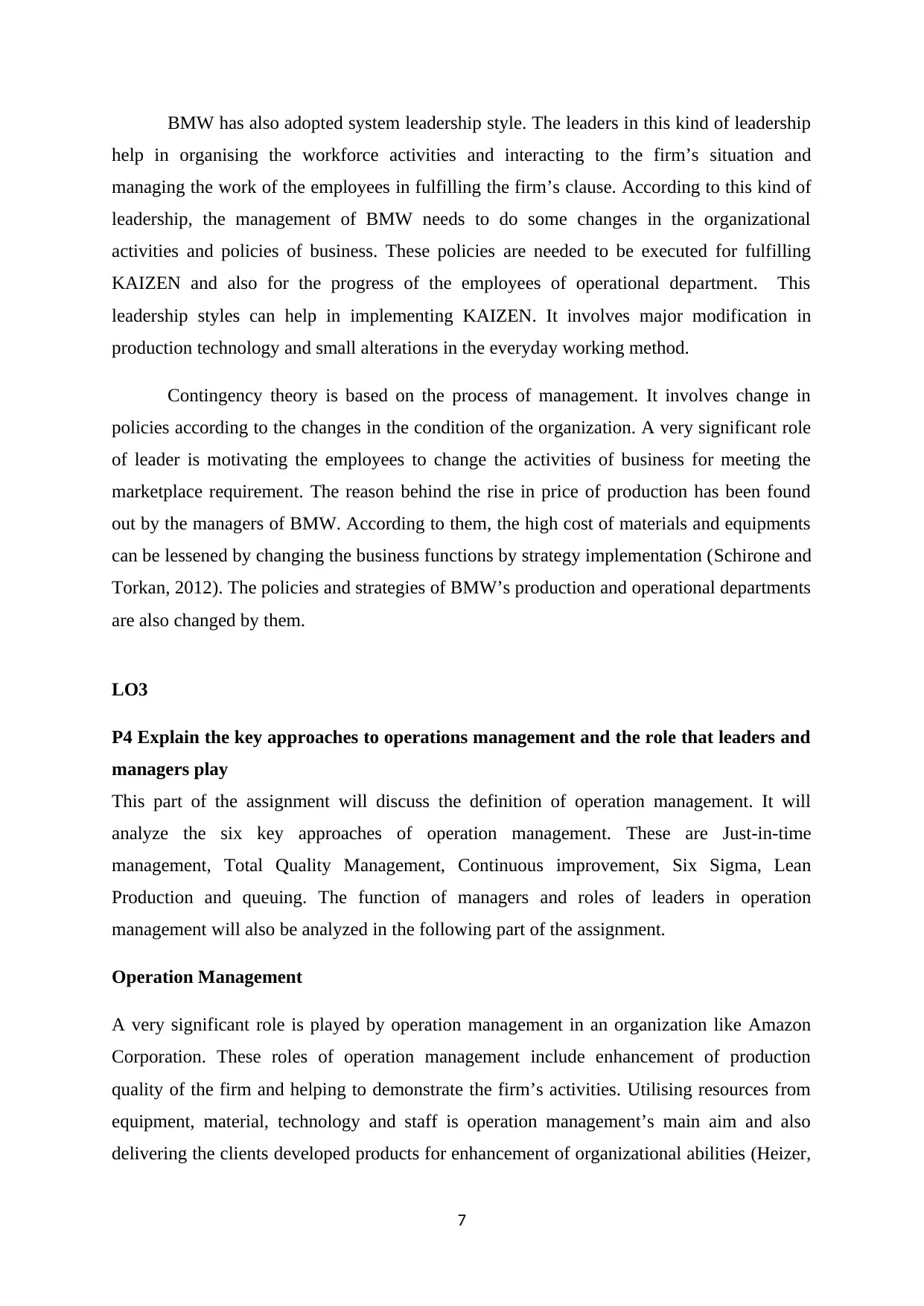
BMW has also adopted system leadership style. The leaders in this kind of leadership
help in organising the workforce activities and interacting to the firm’s situation and
managing the work of the employees in fulfilling the firm’s clause. According to this kind of
leadership, the management of BMW needs to do some changes in the organizational
activities and policies of business. These policies are needed to be executed for fulfilling
KAIZEN and also for the progress of the employees of operational department. This
leadership styles can help in implementing KAIZEN. It involves major modification in
production technology and small alterations in the everyday working method.
Contingency theory is based on the process of management. It involves change in
policies according to the changes in the condition of the organization. A very significant role
of leader is motivating the employees to change the activities of business for meeting the
marketplace requirement. The reason behind the rise in price of production has been found
out by the managers of BMW. According to them, the high cost of materials and equipments
can be lessened by changing the business functions by strategy implementation (Schirone and
Torkan, 2012). The policies and strategies of BMW’s production and operational departments
are also changed by them.
LO3
P4 Explain the key approaches to operations management and the role that leaders and
managers play
This part of the assignment will discuss the definition of operation management. It will
analyze the six key approaches of operation management. These are Just-in-time
management, Total Quality Management, Continuous improvement, Six Sigma, Lean
Production and queuing. The function of managers and roles of leaders in operation
management will also be analyzed in the following part of the assignment.
Operation Management
A very significant role is played by operation management in an organization like Amazon
Corporation. These roles of operation management include enhancement of production
quality of the firm and helping to demonstrate the firm’s activities. Utilising resources from
equipment, material, technology and staff is operation management’s main aim and also
delivering the clients developed products for enhancement of organizational abilities (Heizer,
7
help in organising the workforce activities and interacting to the firm’s situation and
managing the work of the employees in fulfilling the firm’s clause. According to this kind of
leadership, the management of BMW needs to do some changes in the organizational
activities and policies of business. These policies are needed to be executed for fulfilling
KAIZEN and also for the progress of the employees of operational department. This
leadership styles can help in implementing KAIZEN. It involves major modification in
production technology and small alterations in the everyday working method.
Contingency theory is based on the process of management. It involves change in
policies according to the changes in the condition of the organization. A very significant role
of leader is motivating the employees to change the activities of business for meeting the
marketplace requirement. The reason behind the rise in price of production has been found
out by the managers of BMW. According to them, the high cost of materials and equipments
can be lessened by changing the business functions by strategy implementation (Schirone and
Torkan, 2012). The policies and strategies of BMW’s production and operational departments
are also changed by them.
LO3
P4 Explain the key approaches to operations management and the role that leaders and
managers play
This part of the assignment will discuss the definition of operation management. It will
analyze the six key approaches of operation management. These are Just-in-time
management, Total Quality Management, Continuous improvement, Six Sigma, Lean
Production and queuing. The function of managers and roles of leaders in operation
management will also be analyzed in the following part of the assignment.
Operation Management
A very significant role is played by operation management in an organization like Amazon
Corporation. These roles of operation management include enhancement of production
quality of the firm and helping to demonstrate the firm’s activities. Utilising resources from
equipment, material, technology and staff is operation management’s main aim and also
delivering the clients developed products for enhancement of organizational abilities (Heizer,
7
Paraphrase This Document
Need a fresh take? Get an instant paraphrase of this document with our AI Paraphraser
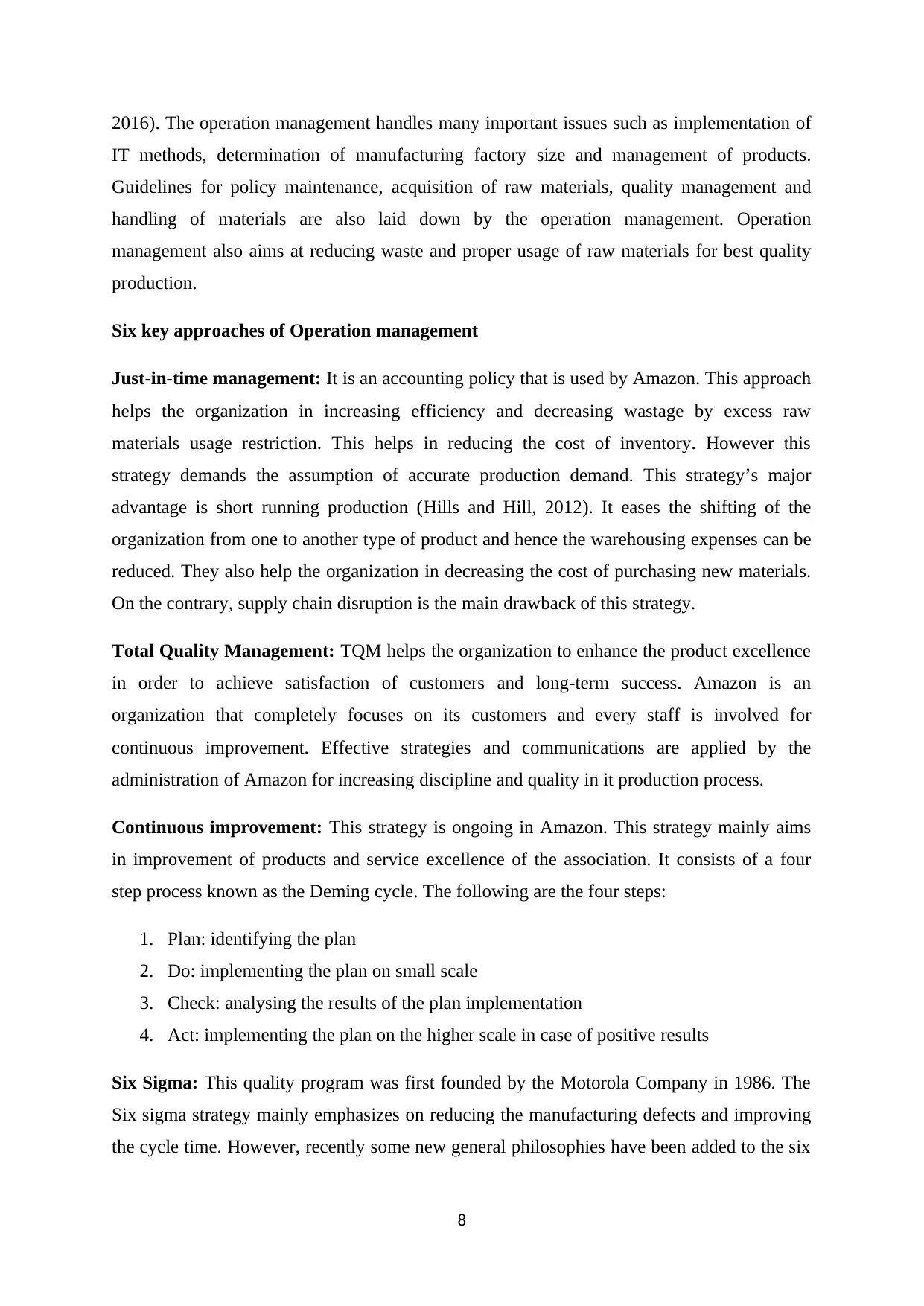
2016). The operation management handles many important issues such as implementation of
IT methods, determination of manufacturing factory size and management of products.
Guidelines for policy maintenance, acquisition of raw materials, quality management and
handling of materials are also laid down by the operation management. Operation
management also aims at reducing waste and proper usage of raw materials for best quality
production.
Six key approaches of Operation management
Just-in-time management: It is an accounting policy that is used by Amazon. This approach
helps the organization in increasing efficiency and decreasing wastage by excess raw
materials usage restriction. This helps in reducing the cost of inventory. However this
strategy demands the assumption of accurate production demand. This strategy’s major
advantage is short running production (Hills and Hill, 2012). It eases the shifting of the
organization from one to another type of product and hence the warehousing expenses can be
reduced. They also help the organization in decreasing the cost of purchasing new materials.
On the contrary, supply chain disruption is the main drawback of this strategy.
Total Quality Management: TQM helps the organization to enhance the product excellence
in order to achieve satisfaction of customers and long-term success. Amazon is an
organization that completely focuses on its customers and every staff is involved for
continuous improvement. Effective strategies and communications are applied by the
administration of Amazon for increasing discipline and quality in it production process.
Continuous improvement: This strategy is ongoing in Amazon. This strategy mainly aims
in improvement of products and service excellence of the association. It consists of a four
step process known as the Deming cycle. The following are the four steps:
1. Plan: identifying the plan
2. Do: implementing the plan on small scale
3. Check: analysing the results of the plan implementation
4. Act: implementing the plan on the higher scale in case of positive results
Six Sigma: This quality program was first founded by the Motorola Company in 1986. The
Six sigma strategy mainly emphasizes on reducing the manufacturing defects and improving
the cycle time. However, recently some new general philosophies have been added to the six
8
IT methods, determination of manufacturing factory size and management of products.
Guidelines for policy maintenance, acquisition of raw materials, quality management and
handling of materials are also laid down by the operation management. Operation
management also aims at reducing waste and proper usage of raw materials for best quality
production.
Six key approaches of Operation management
Just-in-time management: It is an accounting policy that is used by Amazon. This approach
helps the organization in increasing efficiency and decreasing wastage by excess raw
materials usage restriction. This helps in reducing the cost of inventory. However this
strategy demands the assumption of accurate production demand. This strategy’s major
advantage is short running production (Hills and Hill, 2012). It eases the shifting of the
organization from one to another type of product and hence the warehousing expenses can be
reduced. They also help the organization in decreasing the cost of purchasing new materials.
On the contrary, supply chain disruption is the main drawback of this strategy.
Total Quality Management: TQM helps the organization to enhance the product excellence
in order to achieve satisfaction of customers and long-term success. Amazon is an
organization that completely focuses on its customers and every staff is involved for
continuous improvement. Effective strategies and communications are applied by the
administration of Amazon for increasing discipline and quality in it production process.
Continuous improvement: This strategy is ongoing in Amazon. This strategy mainly aims
in improvement of products and service excellence of the association. It consists of a four
step process known as the Deming cycle. The following are the four steps:
1. Plan: identifying the plan
2. Do: implementing the plan on small scale
3. Check: analysing the results of the plan implementation
4. Act: implementing the plan on the higher scale in case of positive results
Six Sigma: This quality program was first founded by the Motorola Company in 1986. The
Six sigma strategy mainly emphasizes on reducing the manufacturing defects and improving
the cycle time. However, recently some new general philosophies have been added to the six
8
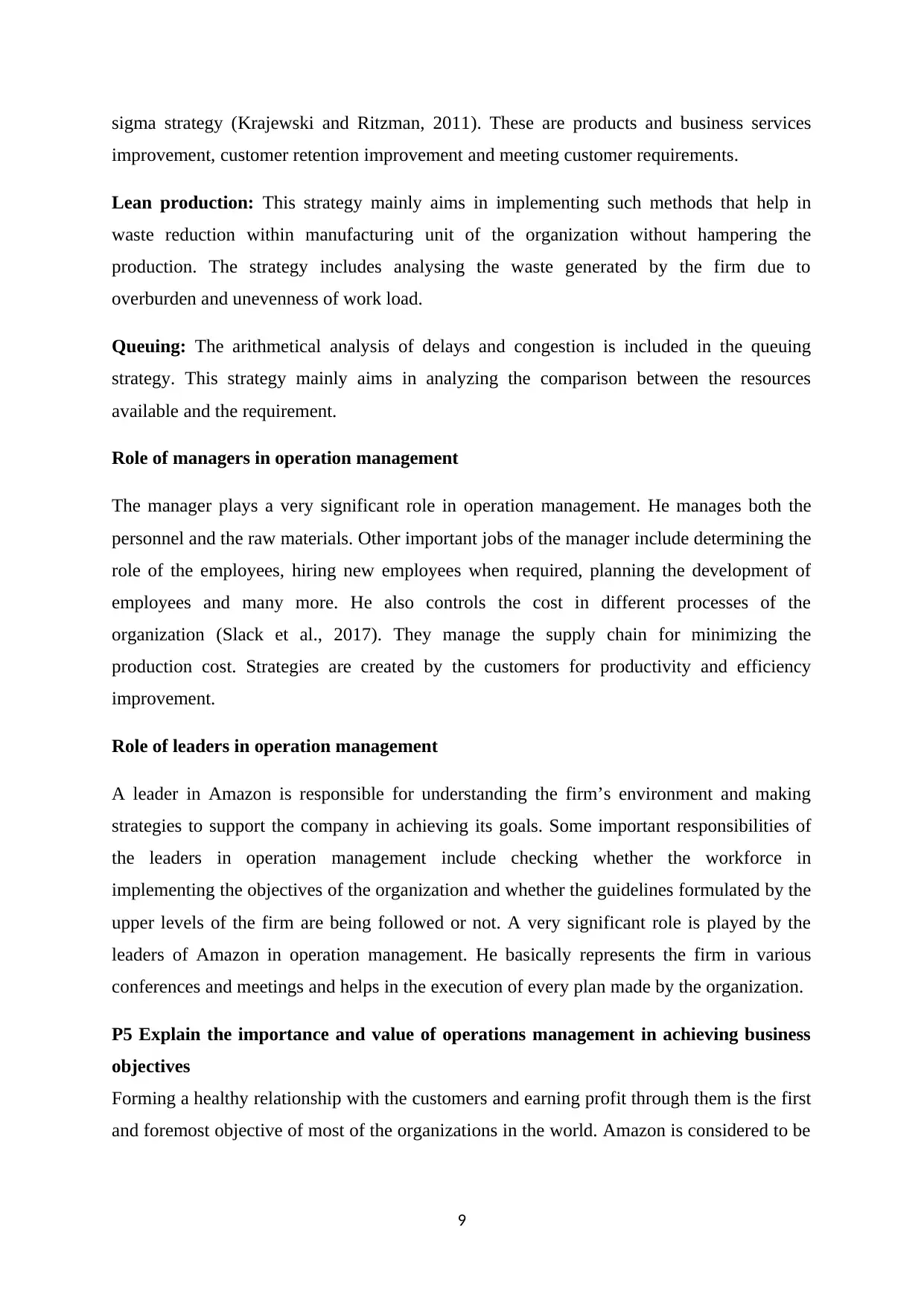
sigma strategy (Krajewski and Ritzman, 2011). These are products and business services
improvement, customer retention improvement and meeting customer requirements.
Lean production: This strategy mainly aims in implementing such methods that help in
waste reduction within manufacturing unit of the organization without hampering the
production. The strategy includes analysing the waste generated by the firm due to
overburden and unevenness of work load.
Queuing: The arithmetical analysis of delays and congestion is included in the queuing
strategy. This strategy mainly aims in analyzing the comparison between the resources
available and the requirement.
Role of managers in operation management
The manager plays a very significant role in operation management. He manages both the
personnel and the raw materials. Other important jobs of the manager include determining the
role of the employees, hiring new employees when required, planning the development of
employees and many more. He also controls the cost in different processes of the
organization (Slack et al., 2017). They manage the supply chain for minimizing the
production cost. Strategies are created by the customers for productivity and efficiency
improvement.
Role of leaders in operation management
A leader in Amazon is responsible for understanding the firm’s environment and making
strategies to support the company in achieving its goals. Some important responsibilities of
the leaders in operation management include checking whether the workforce in
implementing the objectives of the organization and whether the guidelines formulated by the
upper levels of the firm are being followed or not. A very significant role is played by the
leaders of Amazon in operation management. He basically represents the firm in various
conferences and meetings and helps in the execution of every plan made by the organization.
P5 Explain the importance and value of operations management in achieving business
objectives
Forming a healthy relationship with the customers and earning profit through them is the first
and foremost objective of most of the organizations in the world. Amazon is considered to be
9
improvement, customer retention improvement and meeting customer requirements.
Lean production: This strategy mainly aims in implementing such methods that help in
waste reduction within manufacturing unit of the organization without hampering the
production. The strategy includes analysing the waste generated by the firm due to
overburden and unevenness of work load.
Queuing: The arithmetical analysis of delays and congestion is included in the queuing
strategy. This strategy mainly aims in analyzing the comparison between the resources
available and the requirement.
Role of managers in operation management
The manager plays a very significant role in operation management. He manages both the
personnel and the raw materials. Other important jobs of the manager include determining the
role of the employees, hiring new employees when required, planning the development of
employees and many more. He also controls the cost in different processes of the
organization (Slack et al., 2017). They manage the supply chain for minimizing the
production cost. Strategies are created by the customers for productivity and efficiency
improvement.
Role of leaders in operation management
A leader in Amazon is responsible for understanding the firm’s environment and making
strategies to support the company in achieving its goals. Some important responsibilities of
the leaders in operation management include checking whether the workforce in
implementing the objectives of the organization and whether the guidelines formulated by the
upper levels of the firm are being followed or not. A very significant role is played by the
leaders of Amazon in operation management. He basically represents the firm in various
conferences and meetings and helps in the execution of every plan made by the organization.
P5 Explain the importance and value of operations management in achieving business
objectives
Forming a healthy relationship with the customers and earning profit through them is the first
and foremost objective of most of the organizations in the world. Amazon is considered to be
9
⊘ This is a preview!⊘
Do you want full access?
Subscribe today to unlock all pages.

Trusted by 1+ million students worldwide
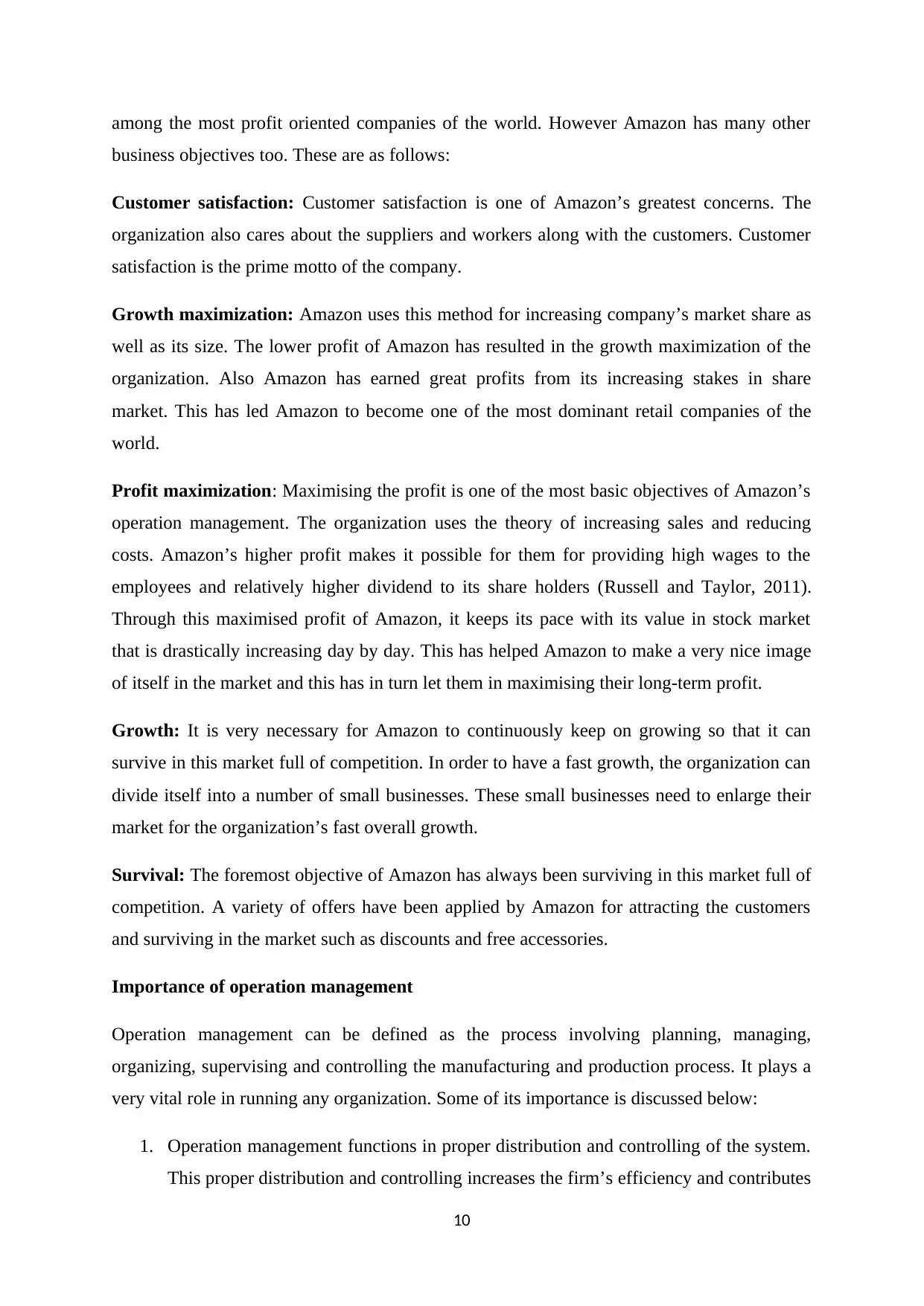
among the most profit oriented companies of the world. However Amazon has many other
business objectives too. These are as follows:
Customer satisfaction: Customer satisfaction is one of Amazon’s greatest concerns. The
organization also cares about the suppliers and workers along with the customers. Customer
satisfaction is the prime motto of the company.
Growth maximization: Amazon uses this method for increasing company’s market share as
well as its size. The lower profit of Amazon has resulted in the growth maximization of the
organization. Also Amazon has earned great profits from its increasing stakes in share
market. This has led Amazon to become one of the most dominant retail companies of the
world.
Profit maximization: Maximising the profit is one of the most basic objectives of Amazon’s
operation management. The organization uses the theory of increasing sales and reducing
costs. Amazon’s higher profit makes it possible for them for providing high wages to the
employees and relatively higher dividend to its share holders (Russell and Taylor, 2011).
Through this maximised profit of Amazon, it keeps its pace with its value in stock market
that is drastically increasing day by day. This has helped Amazon to make a very nice image
of itself in the market and this has in turn let them in maximising their long-term profit.
Growth: It is very necessary for Amazon to continuously keep on growing so that it can
survive in this market full of competition. In order to have a fast growth, the organization can
divide itself into a number of small businesses. These small businesses need to enlarge their
market for the organization’s fast overall growth.
Survival: The foremost objective of Amazon has always been surviving in this market full of
competition. A variety of offers have been applied by Amazon for attracting the customers
and surviving in the market such as discounts and free accessories.
Importance of operation management
Operation management can be defined as the process involving planning, managing,
organizing, supervising and controlling the manufacturing and production process. It plays a
very vital role in running any organization. Some of its importance is discussed below:
1. Operation management functions in proper distribution and controlling of the system.
This proper distribution and controlling increases the firm’s efficiency and contributes
10
business objectives too. These are as follows:
Customer satisfaction: Customer satisfaction is one of Amazon’s greatest concerns. The
organization also cares about the suppliers and workers along with the customers. Customer
satisfaction is the prime motto of the company.
Growth maximization: Amazon uses this method for increasing company’s market share as
well as its size. The lower profit of Amazon has resulted in the growth maximization of the
organization. Also Amazon has earned great profits from its increasing stakes in share
market. This has led Amazon to become one of the most dominant retail companies of the
world.
Profit maximization: Maximising the profit is one of the most basic objectives of Amazon’s
operation management. The organization uses the theory of increasing sales and reducing
costs. Amazon’s higher profit makes it possible for them for providing high wages to the
employees and relatively higher dividend to its share holders (Russell and Taylor, 2011).
Through this maximised profit of Amazon, it keeps its pace with its value in stock market
that is drastically increasing day by day. This has helped Amazon to make a very nice image
of itself in the market and this has in turn let them in maximising their long-term profit.
Growth: It is very necessary for Amazon to continuously keep on growing so that it can
survive in this market full of competition. In order to have a fast growth, the organization can
divide itself into a number of small businesses. These small businesses need to enlarge their
market for the organization’s fast overall growth.
Survival: The foremost objective of Amazon has always been surviving in this market full of
competition. A variety of offers have been applied by Amazon for attracting the customers
and surviving in the market such as discounts and free accessories.
Importance of operation management
Operation management can be defined as the process involving planning, managing,
organizing, supervising and controlling the manufacturing and production process. It plays a
very vital role in running any organization. Some of its importance is discussed below:
1. Operation management functions in proper distribution and controlling of the system.
This proper distribution and controlling increases the firm’s efficiency and contributes
10
Paraphrase This Document
Need a fresh take? Get an instant paraphrase of this document with our AI Paraphraser
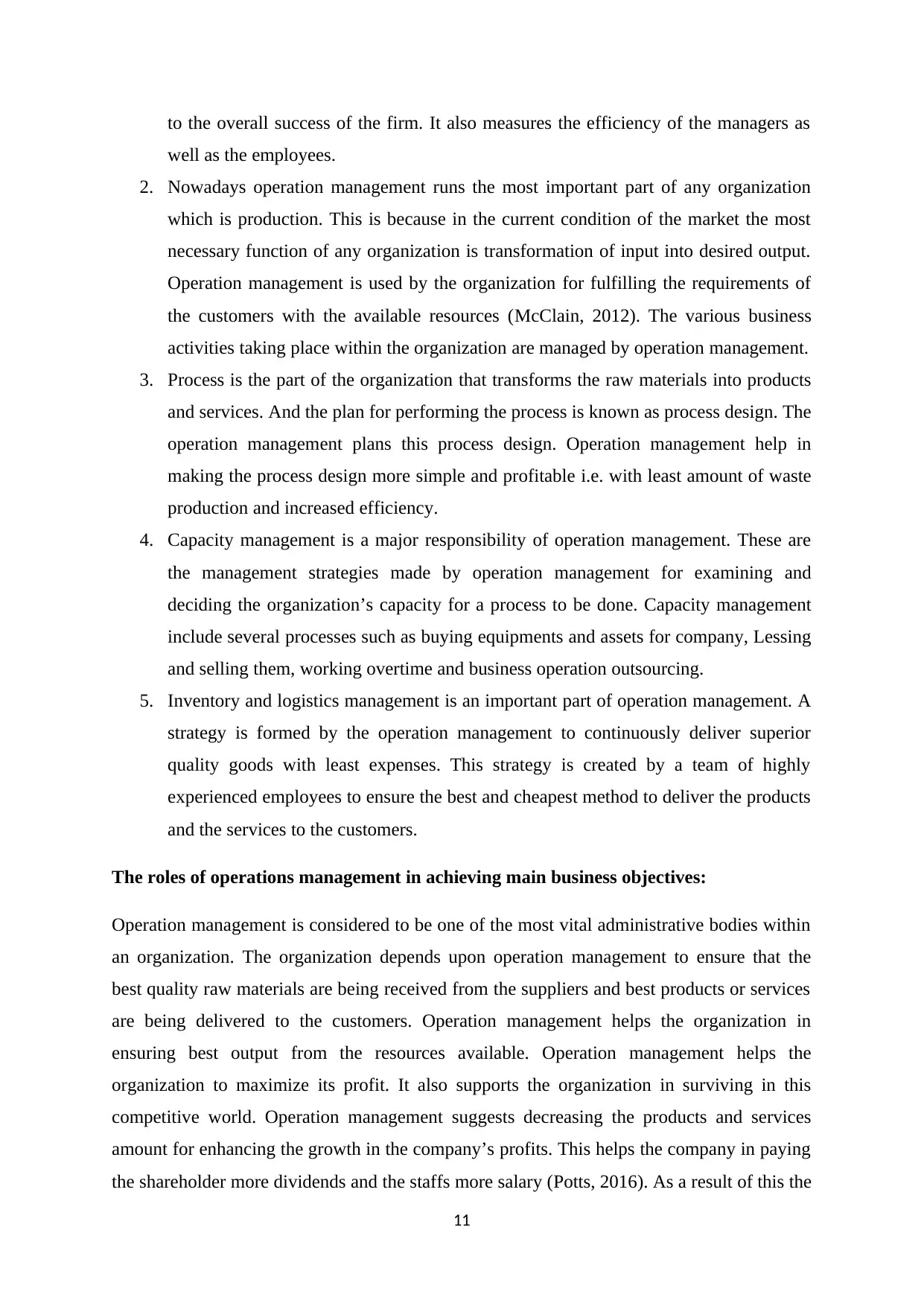
to the overall success of the firm. It also measures the efficiency of the managers as
well as the employees.
2. Nowadays operation management runs the most important part of any organization
which is production. This is because in the current condition of the market the most
necessary function of any organization is transformation of input into desired output.
Operation management is used by the organization for fulfilling the requirements of
the customers with the available resources (McClain, 2012). The various business
activities taking place within the organization are managed by operation management.
3. Process is the part of the organization that transforms the raw materials into products
and services. And the plan for performing the process is known as process design. The
operation management plans this process design. Operation management help in
making the process design more simple and profitable i.e. with least amount of waste
production and increased efficiency.
4. Capacity management is a major responsibility of operation management. These are
the management strategies made by operation management for examining and
deciding the organization’s capacity for a process to be done. Capacity management
include several processes such as buying equipments and assets for company, Lessing
and selling them, working overtime and business operation outsourcing.
5. Inventory and logistics management is an important part of operation management. A
strategy is formed by the operation management to continuously deliver superior
quality goods with least expenses. This strategy is created by a team of highly
experienced employees to ensure the best and cheapest method to deliver the products
and the services to the customers.
The roles of operations management in achieving main business objectives:
Operation management is considered to be one of the most vital administrative bodies within
an organization. The organization depends upon operation management to ensure that the
best quality raw materials are being received from the suppliers and best products or services
are being delivered to the customers. Operation management helps the organization in
ensuring best output from the resources available. Operation management helps the
organization to maximize its profit. It also supports the organization in surviving in this
competitive world. Operation management suggests decreasing the products and services
amount for enhancing the growth in the company’s profits. This helps the company in paying
the shareholder more dividends and the staffs more salary (Potts, 2016). As a result of this the
11
well as the employees.
2. Nowadays operation management runs the most important part of any organization
which is production. This is because in the current condition of the market the most
necessary function of any organization is transformation of input into desired output.
Operation management is used by the organization for fulfilling the requirements of
the customers with the available resources (McClain, 2012). The various business
activities taking place within the organization are managed by operation management.
3. Process is the part of the organization that transforms the raw materials into products
and services. And the plan for performing the process is known as process design. The
operation management plans this process design. Operation management help in
making the process design more simple and profitable i.e. with least amount of waste
production and increased efficiency.
4. Capacity management is a major responsibility of operation management. These are
the management strategies made by operation management for examining and
deciding the organization’s capacity for a process to be done. Capacity management
include several processes such as buying equipments and assets for company, Lessing
and selling them, working overtime and business operation outsourcing.
5. Inventory and logistics management is an important part of operation management. A
strategy is formed by the operation management to continuously deliver superior
quality goods with least expenses. This strategy is created by a team of highly
experienced employees to ensure the best and cheapest method to deliver the products
and the services to the customers.
The roles of operations management in achieving main business objectives:
Operation management is considered to be one of the most vital administrative bodies within
an organization. The organization depends upon operation management to ensure that the
best quality raw materials are being received from the suppliers and best products or services
are being delivered to the customers. Operation management helps the organization in
ensuring best output from the resources available. Operation management helps the
organization to maximize its profit. It also supports the organization in surviving in this
competitive world. Operation management suggests decreasing the products and services
amount for enhancing the growth in the company’s profits. This helps the company in paying
the shareholder more dividends and the staffs more salary (Potts, 2016). As a result of this the
11
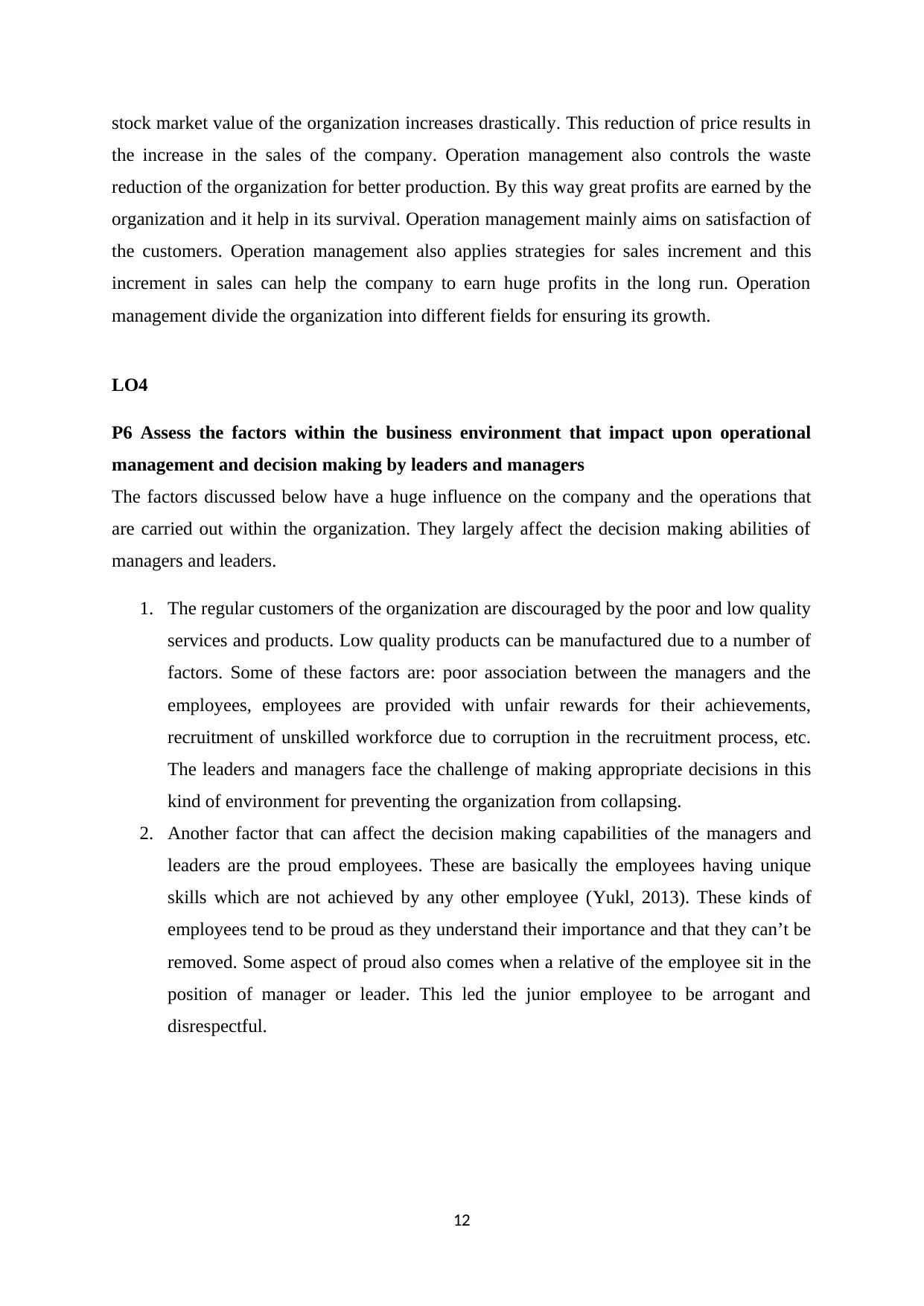
stock market value of the organization increases drastically. This reduction of price results in
the increase in the sales of the company. Operation management also controls the waste
reduction of the organization for better production. By this way great profits are earned by the
organization and it help in its survival. Operation management mainly aims on satisfaction of
the customers. Operation management also applies strategies for sales increment and this
increment in sales can help the company to earn huge profits in the long run. Operation
management divide the organization into different fields for ensuring its growth.
LO4
P6 Assess the factors within the business environment that impact upon operational
management and decision making by leaders and managers
The factors discussed below have a huge influence on the company and the operations that
are carried out within the organization. They largely affect the decision making abilities of
managers and leaders.
1. The regular customers of the organization are discouraged by the poor and low quality
services and products. Low quality products can be manufactured due to a number of
factors. Some of these factors are: poor association between the managers and the
employees, employees are provided with unfair rewards for their achievements,
recruitment of unskilled workforce due to corruption in the recruitment process, etc.
The leaders and managers face the challenge of making appropriate decisions in this
kind of environment for preventing the organization from collapsing.
2. Another factor that can affect the decision making capabilities of the managers and
leaders are the proud employees. These are basically the employees having unique
skills which are not achieved by any other employee (Yukl, 2013). These kinds of
employees tend to be proud as they understand their importance and that they can’t be
removed. Some aspect of proud also comes when a relative of the employee sit in the
position of manager or leader. This led the junior employee to be arrogant and
disrespectful.
12
the increase in the sales of the company. Operation management also controls the waste
reduction of the organization for better production. By this way great profits are earned by the
organization and it help in its survival. Operation management mainly aims on satisfaction of
the customers. Operation management also applies strategies for sales increment and this
increment in sales can help the company to earn huge profits in the long run. Operation
management divide the organization into different fields for ensuring its growth.
LO4
P6 Assess the factors within the business environment that impact upon operational
management and decision making by leaders and managers
The factors discussed below have a huge influence on the company and the operations that
are carried out within the organization. They largely affect the decision making abilities of
managers and leaders.
1. The regular customers of the organization are discouraged by the poor and low quality
services and products. Low quality products can be manufactured due to a number of
factors. Some of these factors are: poor association between the managers and the
employees, employees are provided with unfair rewards for their achievements,
recruitment of unskilled workforce due to corruption in the recruitment process, etc.
The leaders and managers face the challenge of making appropriate decisions in this
kind of environment for preventing the organization from collapsing.
2. Another factor that can affect the decision making capabilities of the managers and
leaders are the proud employees. These are basically the employees having unique
skills which are not achieved by any other employee (Yukl, 2013). These kinds of
employees tend to be proud as they understand their importance and that they can’t be
removed. Some aspect of proud also comes when a relative of the employee sit in the
position of manager or leader. This led the junior employee to be arrogant and
disrespectful.
12
⊘ This is a preview!⊘
Do you want full access?
Subscribe today to unlock all pages.

Trusted by 1+ million students worldwide
1 out of 15
Related Documents
Your All-in-One AI-Powered Toolkit for Academic Success.
+13062052269
info@desklib.com
Available 24*7 on WhatsApp / Email
![[object Object]](/_next/static/media/star-bottom.7253800d.svg)
Unlock your academic potential
Copyright © 2020–2025 A2Z Services. All Rights Reserved. Developed and managed by ZUCOL.




